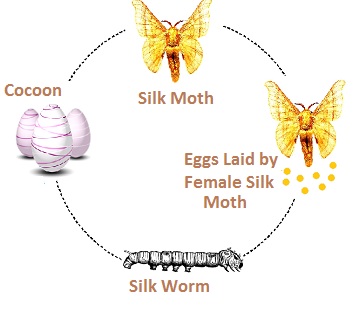
 Data Structure
Data Structure Networking
Networking RDBMS
RDBMS Operating System
Operating System Java
Java MS Excel
MS Excel iOS
iOS HTML
HTML CSS
CSS Android
Android Python
Python C Programming
C Programming C++
C++ C#
C# MongoDB
MongoDB MySQL
MySQL Javascript
Javascript PHP
PHPPhysics
Chemistry
Biology
Mathematics
English
Economics
Psychology
Social Studies
Fashion Studies
Legal Studies
- Selected Reading
- UPSC IAS Exams Notes
- Developer's Best Practices
- Questions and Answers
- Effective Resume Writing
- HR Interview Questions
- Computer Glossary
- Who is Who
Steps for the production of silk are given below in a jumbled order. Arrange them in their proper sequence. [NCERT Exemplar](a) Eggs are warmed to a suitable temperature for the larvae to hatch from eggs.
(b) Fibers are taken out from the cocoon.
(c) After 25 to 30 days, the caterpillars stop eating and start spinning cocoons.
(d) The larvae/caterpillars or silkworms are kept in clean trays along with freshly chopped mulberry leaves.
(e) Female silk moths lay eggs.
(f) Cocoons are kept under the sun or boiled in water.
Steps for the production of silk can be arranged in their proper sequence as:
(e) Female silk moths lay eggs.
(a) Eggs are warmed to a suitable temperature for the larvae to hatch from eggs.
(d) The larvae/caterpillars or silkworms are kept in clean trays along with freshly chopped mulberry leaves.
(c) After 25 to 30 days, the caterpillars stop eating and start spinning cocoons.
(f) Cocoons are kept under the sun or boiled in water.
(b) Fibers are taken out from the cocoon.
The life cycle of the silk moth:

- The female silk moth lays eggs.
- When an egg hatches, a tiny caterpillar crawls out. This is the silkworm, or larva. The silkworm feeds on mulberry leaves and grows.
- When it is ready to enter the next stage in its life cycle, it first weaves a net to hold itself. It then secretes a fibre made of proteins, which hardens on exposure to air. This is the silk fibre. It covers itself completely with this fibre, to form the cocoon.
- At this stage, the larva is called a pupa. The pupa grows and changes inside the cocoon.
- A few weeks later, the cocoon opens and an adult moth comes out.

Advertisements

To Continue Learning Please Login